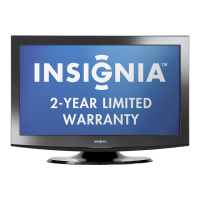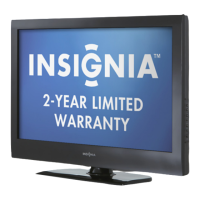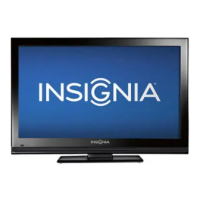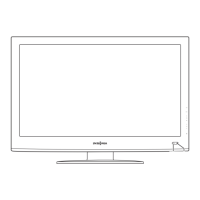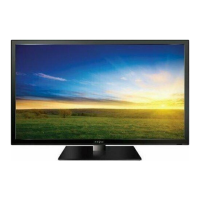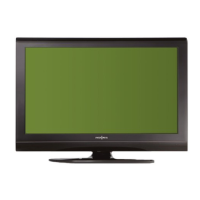Do you have a question about the Insignia NS-32L450A11 and is the answer not in the manual?
Provides essential safety tips for TV placement and handling to prevent injuries.
Guidance on safely mounting the TV on a wall, emphasizing proper support and installation.
Crucial safety warnings regarding electrical shock, lightning, and high voltage.
Instructions for careful handling of the LCD screen to prevent damage or injury from broken glass.
Ensuring the TV operates safely after service or repair by a qualified technician.
Guidance on using the correct power source and unplugging the TV when not in use.
Conditions under which the TV requires professional repair and safety precautions.
Instructions for grounding external antennas for surge protection.
Advice on preventing condensation issues when moving the TV between environments.
Caution against placing wireless and cell phones near the TV to avoid interference.
Steps for securely attaching a wall mount bracket to the TV.
Identification and function of the physical buttons on the TV.
Diagram and description of connections available on the rear panel of the TV.
Instructions for correctly inserting batteries into the remote control.
Proper aiming of the remote control towards the TV's sensor.
Guidance on placing the remote control in its holder.
Steps to program the remote to control other home theater devices.
Procedure for searching for remote control codes if the brand is not listed.
How to check the five-digit code assigned to your TV or other devices.
Using the remote's learning feature to copy functions from original remotes.
Steps to teach the remote a new button function.
How to remove a learned button function from the remote.
Procedure to clear all learned button functions for a specific mode.
Setting volume control to operate a specific device regardless of mode.
How to lock channel changing functions to a specific device.
Using the remote's function to move or copy button functions between modes.
Steps to program a universal remote to operate the Insignia TV.
How to connect the TV's AC power cord to a wall outlet.
Connecting an antenna or cable TV directly to the TV.
Connecting a cable or satellite box to the TV using various cable types.
Steps for connecting devices with HDMI output to the TV.
How to connect devices with DVI output using an HDMI adapter.
Connecting devices using component video cables.
Connecting devices using S-Video cables.
Instructions for connecting a VCR to the television.
Connecting camcorders or video game consoles to the TV.
Steps for connecting a computer to the TV via VGA or HDMI.
How to connect USB devices like flash drives for viewing photos.
How to connect headphones to the TV's audio jack.
Connecting a digital audio system using an optical cable.
Connecting an analog audio system using audio cables.
Ensuring necessary connections and remote batteries are ready before setup.
How to power the TV on and off using the remote or power button.
Switching between different video sources connected to the TV.
How to use the remote control's directional buttons to navigate menus.
How to adjust picture settings like brightness, contrast, and color.
Displaying channel information, program details, and guide data.
How to control the TV's volume using the remote.
Detailed steps for adjusting various picture settings on the TV.
Adjusting picture settings when a computer is connected via VGA.
How to adjust sound settings like Audyssey, SRS TruSurround HD, and EQ.
Selecting audio modes for analog channels.
Turning off the TV screen to listen to audio only.
Scanning for and storing available channels automatically.
Procedure to hide channels from the channel list.
Creating and managing a list of favorite channels for quick access.
How to access and view channels from your favorite list.
Assigning custom names to channels for easier identification.
Setting up parental controls to restrict program access based on ratings.
How to set or change the parental control access password.
Locking the TV's physical buttons to prevent unauthorized use.
How to block TV programs that do not have a rating.
Setting specific rating levels for movies and TV shows.
Procedure to download classification data for parental controls.
How to turn the optional subtitles feature on or off.
Selecting display modes for analog optional subtitles.
Customizing the appearance of digital optional subtitles.
Setting the TV's clock and date.
Setting the time before the TV automatically turns off.
Changing the menu language and transparency settings.
Assigning custom names to input sources for easier identification.
Enabling or disabling the automatic detection of input sources.
Configuring the INlink feature for controlling HDMI-CEC devices.
Managing the automatic power-off function for connected devices.
Customizing slideshow options like repeat, shuffle, speed, and transition.
How to reset all customizable settings back to factory defaults.
Connecting a USB device and selecting USB as the input source.
Navigating and viewing JPEG photos stored on a USB device.
Quickly accessing and viewing photos added to the favorite list.
Displaying photos from a selected folder as an automated slideshow.
Solutions for when the TV does not turn on.
Troubleshooting steps for a non-functional remote control.
Resolving issues with programmed remote control functions.
Troubleshooting for front panel buttons and INlink functionality.
Technical details about the LCD panel, resolution, color, and viewing angles.
List of items provided with the TV, such as cables and remote control.
Lists of codes for various audio equipment and receivers.
Warranty details for purchases in the US and Canada.
Information on how long the warranty period lasts.
Details on what the warranty covers, including defects in material and workmanship.
Instructions for getting warranty service, including store returns or home service.
Information on the geographical validity of the warranty.
Exclusions from warranty coverage, such as cosmetic damage or misuse.
